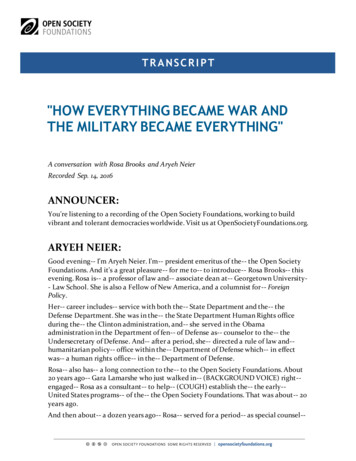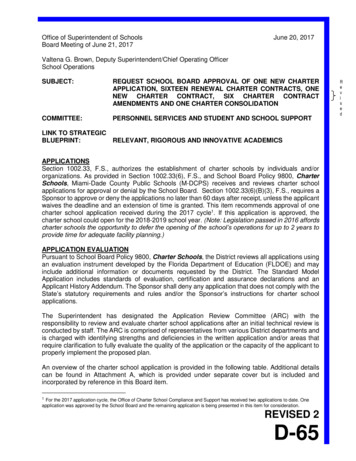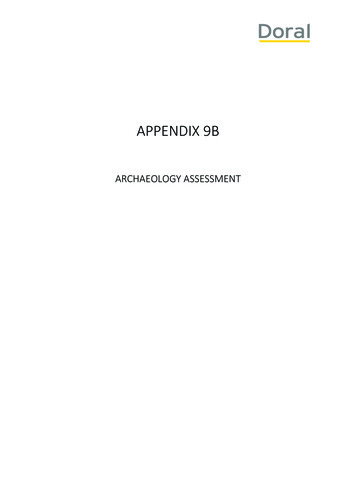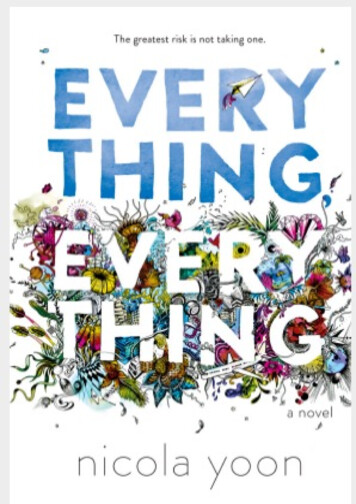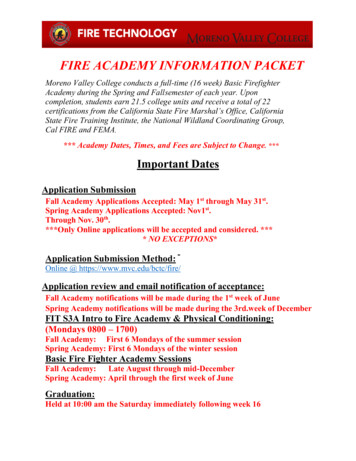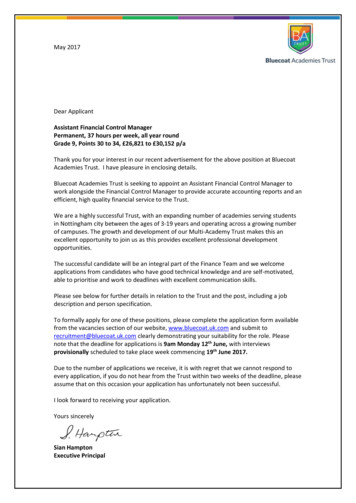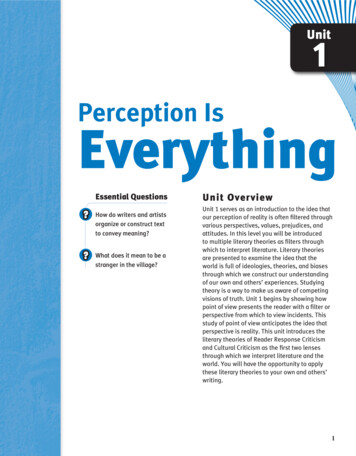
Transcription
Unit1Perception IsEverythingEssential Questions?How do writers and artistsorganize or construct textto convey meaning?What does it mean to be astranger in the village?Unit OverviewUnit 1 serves as an introduction to the idea thatour perception of reality is often filtered throughvarious perspectives, values, prejudices, andattitudes. In this level you will be introducedto multiple literary theories as filters throughwhich to interpret literature. Literary theoriesare presented to examine the idea that theworld is full of ideologies, theories, and biasesthrough which we construct our understandingof our own and others’ experiences. Studyingtheory is a way to make us aware of competingvisions of truth. Unit 1 begins by showing howpoint of view presents the reader with a filter orperspective from which to view incidents. Thisstudy of point of view anticipates the idea thatperspective is reality. This unit introduces theliterary theories of Reader Response Criticismand Cultural Criticism as the first two lensesthrough which we interpret literature and theworld. You will have the opportunity to applythese literary theories to your own and others’writing.
1Perception Is EverythingGoalsC To understand theContentsLearning Focus: Perspective and the Individual . . . . . . . . . . . . . . . . . 4Activities:1.1Previewing the Unit . . . . . . . . . . . . . . . . . . . . . . . . . . . . . . . . . . . . . . 51.2Perception Is Everything. . . . . . . . . . . . . . . . . . . . . . . . . . . . . . . . . . . 61.3Importance of Perspective . . . . . . . . . . . . . . . . . . . . . . . . . . . . . . . . . 71.4Different Ways of Seeing the World . . . . . . . . . . . . . . . . . . . . . . . . . 91.5Different Ways of Reading the Text. . . . . . . . . . . . . . . . . . . . . . . . . 11Poetry: “My Papa’s Waltz,” by Theodore Roethke1.6Introducing Reader Response Critical Theory . . . . . . . . . . . . . . . . 12Expository Text: “The Elements of ReaderResponse Criticism”1.7Applying Reader Response Criticism. . . . . . . . . . . . . . . . . . . . . . . . 15Poetry: “in Just-,” by E.E. CummingsPoetry: “The Last Word,” by Peter DavisonPoetry: “Mushrooms,” by Sylvia PlathAcademic VocaBulary1.8Reader ResponseCriticismSeeing the World from My Perspective . . . . . . . . . . . . . . . . . . . . . 19Poetry: “I Remember,” by Edward Montez1.9Another Perpective on the World. . . . . . . . . . . . . . . . . . . . . . . . . . . 23Novel: Prologue from Invisible Man, by Ralph Ellisonrelationship betweenperspective and criticaltheoryC To apply critical theoriesto various texts studiedand createdC To control andmanipulate textualelements in writing toclearly and effectivelyconvey a controllingidea or thesisCultural Criticism1.10 A Symbolic Perception of Self . . . . . . . . . . . . . . . . . . . . . . . . . . . . . 29Novel: “Four Skinny Trees,” vignette from The Houseon Mango Street, by Sandra Cisneros1.11 Exploring Perspectives in Visual Art . . . . . . . . . . . . . . . . . . . . . . . . 311.12 Exploring a Photo Essay. . . . . . . . . . . . . . . . . . . . . . . . . . . . . . . . . . 341.13 Digging for Deeper Meaning. . . . . . . . . . . . . . . . . . . . . . . . . . . . . . . 35Essay: “On Seeing England for the First Time,”by Jamaica KincaidEmbedded Assessment 1 Creating a Photo Essay . . . . . . . . . . . . . 39 SpringBoard English Textual Power Senior English 2010 College Board. All rights reserved.Unit
Learning Focus: Perspective and Culture . . . . . . . . . . . . . . . . . . . . . 441.14 What Is Cultural Criticism?. . . . . . . . . . . . . . . . . . . . . . . . . . . . . . . . 45Poetry: “Speaking with Hands,” by Luis Rodriguez1.15 Poetic Conversations . . . . . . . . . . . . . . . . . . . . . . . . . . . . . . . . . . . . 48Poetry: “The White Man’s Burden,” by Rudyard KiplingPoetry: “The Brown Man’s Burden,” by Henry Labouchère1.16 A Deeper Understanding of Imperialism. . . . . . . . . . . . . . . . . . . . . 54Song: “Rule Britannia!” by James Thomson and ThomasAugustine Arne1.17 Reading with a Cultural Criticism Lens . . . . . . . . . . . . . . . . . . . . . . 57Reflective Essay: “Shooting an Elephant,” by George Orwell1.18 Being a Stranger . . . . . . . . . . . . . . . . . . . . . . . . . . . . . . . . . . . . . . . . 65*Film: Clips from Edward Scissorhands, directedby Tim Burton1.19 Two Different Worlds. . . . . . . . . . . . . . . . . . . . . . . . . . . . . . . . . . . . . 66Novel: Excerpt of “Lindo Jong: Double Face,”from The Joy Luck Club by Amy Tan1.20 Understanding the Stranger’s Perception of a Village. . . . . . . . . . 69Reflective Essay: “Stranger in the Village” by James BaldwinEmbedded Assessment 2 Writing a Reflective Essay . . . . . . . . . . . 80 2010 College Board. All rights reserved.Unit Reflection . . . . . . . . . . . . . . . . . . . . . . . . . . . . . . . . . . . . . . . . . . . . . . 84*Texts not included in these materials.
Learning Focus:Perspective and the IndividualUntil we realize the world is full of ideologies, theories, and biases throughwhich we filter our understanding of our own and others’ experiences, we areblind to the real truths of the world. Consider the perspectives presented inthe following quotes: “If all you have is a hammer, everything looks like a nail.” Anonymous “Until lions tell their stories, tales of hunting will glorify the hunter.”African proverb “Theory is subversive because it puts authority in question.” StephenBonnycastle, In Search of AuthorityLiterary theory is just one example of how competing perspectives color theway literature and life are interpreted. Studying a variety of critical theoriesis a way to become aware of competing visions of truth, to learn that a text,like life, is seen through a filter of ideologies and theories and perspectives.Being able to apply different theories to a text expands the limits of a reader’sworldview and adds dimension to reading and understanding a text. Criticaltheory highlights the fact that there is no one, simple vision of the truth. Truthis a complicated product of multiple perspectives.See Appendix 1 in the back of your book for descriptions of all six literarycritical theories. You will want to refer to this information for definitions,characteristics, and examples of different literary perspectives. This list isnot intended to be an exhaustive representation of these complex theoreticalperspectives, but rather a brief introduction. Your teacher may expect you todo further research on one or more of these literary theories. SpringBoard English Textual Power Senior English 2010 College Board. All rights reserved.Reader Response Critical Theory is the first of six literary critical theories youwill study. Reader Response Criticism focuses on a reader’s engagement witha specific text and the dynamics that emerge as meaning is created betweenthe text presented by the author and the reader’s interpretation of it. Thistheory highlights the idea that individuals often read and interpret the sametexts differently, allowing texts to be challenged, evaluated, and critiqued.
ActivityPreviewing the Unit1.1SUGGESTED Learning Strategies: Think-Pair-Share, Skimming/Scanning,Close Reading, Marking the Text, Summarizing/Paraphrasing, Graphic OrganizerEssential Questions1. How do writers and artists organize or construct text to convey meaning?2. What does it mean to be a stranger in the village?Unit Overview and Learning Focus 2010 College Board. All rights reserved.Predict what you think this unit is about. Use the words or phrasesthat stood out to you when you read the Unit Overview and theLearning Focus.Embedded Assessment 1What knowledge must you have (what do you need to know) to succeedon Embedded Assessment 1? What skills must you have (what must yoube able to do)?Unit 1 Perception Is Everything
Activity1.2Perception Is EverythingSUGGESTED Learning Strategies: Think-Pair-Share,Summarizing/Paraphrasing, QuickwriteLiterary termsPerception is a mentalconcept or point of view.An aphorism is a succinct statement expressing an opinion, perception,or general truth. Choose five aphorisms that you especially like fromthe following list. In your group, paraphrase the quotes you havechosen and explain how the quotes relate to the ideas of seeing andunderstanding. “What you see and hear depends a good deal on where you arestanding; it also depends on what sort of person you are.”— C. S. Lewis “The voyage of discovery is not in seeking new landscapes but inhaving new eyes.” — Marcel Proust “You can complain because roses have thorns, or you can rejoicebecause thorns have roses.” — Tom Wilson “All photographs are accurate. None of them is the truth.”— Richard Avedon “There are things known and there are things unknown, and inbetween are the doors of perception.” — Aldous Huxley “The eye sees only what the mind is prepared to comprehend.”— Henri Bergson “Better keep yourself clean and bright; you are the windowthrough which you must see the world.” — George Bernard Shaw “Language forces us to perceive the world as men present it tous.” — Julia Penelope “If we spoke a different language, we would perceive a somewhatdifferent world.” — Ludwig WittgensteinQuickwrite: Choose one quote from the list and quickwrite for10 minutes about the truth it conveys. Then create an original aphorismexpressing your perception or a general truth about the world. SpringBoard English Textual Power Senior English 2010 College Board. All rights reserved. “Whilst part of what we perceive comes through our senses fromthe object before us, another part (and it may be the larger part)always comes out of our own mind.” — William James
Importance of PerspectiveActivity1.3SUGGESTED Learning Strategies: Graphic OrganizerEveryone views the world with a unique perspective. That perspectivecan be influenced by a number of factors, including life experiences,education, significant people, occupations, political affiliations, andnumerous other elements that serve to help shape individual attitudes.Take something as simple as music. Think of one of your favorite songs.Why do you like that song? Does it address an issue that is importantto you? Does it feature an instrument that you especially enjoy? Doyou merely enjoy it for the rhythm it contains? Your answers to thesequestions depend on your unique perspective, a perspective that hasbeen influenced in many ways over the course of your life.Literary termsA scenario is an outline, abrief account, or a synopsisof events.In order to illustrate this idea, consider the following scenario: n your way to school, you see another student who has beenOpulled over by a police officer. You see the student’s frustrationas the officer writes out what appears to be a traffic ticket.Complete the graphic organizer on the following page, imagining theresponse of each individual in the situation. Consider these points whenresponding: Each person described in the scenario will have a distinctlydifferent perspective on the situation. 2010 College Board. All rights reserved. Each person described in the scenario will have a different levelof connection to the consequences of the situation, which in turnwill influence the response. For example, someone will have topay for the ticket. Each person described in the scenario will also be subject to avariety of factors unrelated to the ticket that will also influencethe response. For example, if the traffic is moving more slowlydue to the ticket distraction, someone may be late for work.Unit 1 Perception Is Everything
Activity 1.3continuedImportance of PerspectiveIndividualPerspectiveThoughts RunningThrough ThisPerson’s MindPossible FactorsInfluencing How ThisPerson Is RespondingPrimary Goal orObjective of ThisPersonStudent BeingTicketedOfficer Writingthe TicketParent of StudentBeing TicketedWho Happens to BeDriving ByDriving byBest Friend ofStudent BeingTicketedYou SpringBoard English Textual Power Senior English 2010 College Board. All rights reserved.Favorite Teacher
Different Ways of Seeing the WorldActivity1.4SUGGESTED Learning Strategies: QHT, Activating Prior Knowledge,Close Reading, Think-Pair-ShareScan the words listed below and use the following coding system torate your level of understanding with the media production elements ofphotography.(Q): Signals a question—I have never heard of this word before.(H): Signals familiarity—I have heard of the word before and here is thecontext in which I have heard it.(T): Signals knowledge—I know what this word means and here is anexample.1. Frame5. Image2. Subject6. Composition3. Cropping7. Space4. LightingLiterary termsThe mise en scène is thecomposition, or setting, ofan image. 2010 College Board. All rights reserved.Writing Prompt: Study the photograph suggested by your teacher, anduse the space below to write a brief description that reflects the mise enscène, or composition, of the image.Unit 1 Perception Is Everything
Activity 1.4continuedDifferent Ways of Seeing the WorldAnalyzing Visuals/Art: Using the OPTICS StrategyBreif Description ofOPTIC StepsLiteral DetailedObservationsInterpretation ofObservationsOverview: Conduct a briefoverview of the visual byexamining it carefully. Note thedetails: images, colors, shapes,position or angle in the frame.Title/Text: Read the title andany text within the visualso that you are clear on thesubject. Read all labels andconsider how they add to yourinterpretation.Interrelationships: Use thetitle as your theory and theparts of the visual as yourclues to detect and identifythe interrelationships in thevisual/art.Conclusions: Draw conclusionsabout the visual as a whole.10 SpringBoard English Textual Power Senior English 2010 College Board. All rights reserved.Parts: Key in on the parts ofthe visual by reading all labels,images, and symbols, notingany additonal details that seemimportant.
Different Ways of Reading the TextActivity1.5SUGGESTED Learning Strategies: Free Writing, Marking the TextRead the following poem multiple times and think about thespeaker’s point of view.About the AuthorPoetryby Theodore Roethke The whisky on your breathcould make a small boy dizzy;But I hung on like death:Such waltzing was not easy. We romped until the pans5Slid from the kitchen shelf;My mother’s countenance1Could not unfrown itself. The hand that held one wrist 2010 College Board. All rights reserved.Was battered on one knuckle;10At every step you missedMy right ear scraped a buckle. You beat time on my headWith a palm caked hard by dirt,Then waltzed me off to bedThe Midwest poetTheodore Roethke(1908–1963) createdpoetry notable forits introspectionand fascination withnature. The son of agreenhouse owner,Roethke was impressedwith greenhouses’ability to bring lifeto the cold Michiganclimate. Educated at theUniversity of Michiganand Harvard University,Roethke taught atnumerous universitieswhere his enthusiasmfor poetry made hima popular professor.Roethke received aPulitzer Prize for TheWaking (1953) and theNational Book Award forthe collection Words forthe Wind (1957).15Still clinging to your shirt.Freewrite: After studying the poem, freewrite to explore your initialinterpretation of the text. Mark the text to identify words and phrases thatsupport your interpretation.1countenance: facial expressionUnit 1 Perception Is Everything 11
Activity1.6Introducing Reader ResponseCritical TheorySUGGESTED Learning Strategies: Marking the Text, DiscussionGroups, Think-Pair-ShareAcademic VocaBularyReader Response Criticismfocuses on a reader’s activeengagement with a pieceof print or nonprint text.The reader’s response toany text is shaded by thereader’s own experiences,social ethics, moral values,and general views of theworld.Reader Response Critical TheoryYour personal attitudes, beliefs, and experiences influence how youderive meaning from text. Examining the way in which you understandtext involves adopting critical lenses. A critical lens is a way of judgingor analyzing a work of literature.Much as putting on a pair of tinted lenses colors the way you look atthe world, critical lenses influence how you study and perceive text.The Reader Response Criticism asks you to consider the role yourposition as a reader plays whenever you look at text. The critical lens ofReader Response Critical Theory focuses on the relationship among thereader, the reader’s situation, and the text. The theory suggests that theprocess of making meaning relies not only on the text itself, but also onthe qualities and motivations of the individual who is interacting withthe text. See Appendix 1 for more information on this theory.The diagram below illustrates this idea.MeaningReaderTextReading Situation: the circumstances surrounding the reading,including the purposes for readingReader: the individual engaged in the reading processText: what is being read12 SpringBoard English Textual Power Senior English 2010 College Board. All rights reserved.ReadingSituation
Activity 1.6continuedIn the Reading Situation – Reader – Text model, the reader constructsmeaning as a result of the interaction among all of these individualfactors. Consider the following examples: Scenario 1: A senior is assigned to read a chapter from the bookhe is studying in English class. The senior has tickets to see ashow that night but knows that there will be a quiz on the chapterthe next day. He is a strong reader but has not enjoyed the bookthe class is studying. What factors are influential on the reader,situation, and text? How would these factors impact the student’sability to make meaning of that chapter? 2010 College Board. All rights reserved. Scenario 2: A senior is part of a group of four students preparinga presentation about optical illusions. She volunteered to doInternet research to find information to bring back to the rest ofthe group. She is a computer whiz and fascinated by the topic,and spends several hours on the Internet finding examplesof optical illusions, but hasn’t done much real reading orinvestigating of the information about optical illusions. The nextday in class the group is expecting some material to read, butthe senior brings a collection of optical illusions to show theminstead. How did the reader, situation, and text impact the abilityto make meaning?Unit 1 Perception Is Everything 13
Activity 1.6continuedIntroducing Reader ResponseCritical TheoryThe Elements of Reader Response CriticismThe ReaderOne significant factor in Reader Response Critical Theory is that it takesinto account the person doing the reading. This model takes the readerinto account in a number of ways, including, but not limited to, theindividual’s opinions, attitudes, beliefs, and background knowledge.Consider some of the ways in which your personality, attitudes, andpersonal goals influence you every time you are looking at text. Forexample, what do you read on your own? Do you read novels, or do youread sports magazines? If you read quite a few novels, then being askedto read 30 pages in a single session might not seem difficult. This is justone way in which you influence the reading process.The Reading SituationThe TextThe text is defined as whatever is being read. Textual features vary,depending on the source. For example, a textbook will present textdifferently than a magazine or a pamphlet. Numerous other factorsinfluence the text, from level of difficulty to the font.Think-Pair-Share: With a small group, create a summary statement ofall that you have learned about Reader Response Critical theory. Shareyour responses and choose the clearest, most comprehensive summarystatement.14 SpringBoard English Textual Power Senior English 2010 College Board. All rights reserved.The reading situation includes why you are engaged in reading, whenyou are reading, and where you are reading. Some of these factors arewithin your control, but others are not. Anytime that you read a textbecause someone else told you to read it, the choice has been made foryou. How much you are supposed to read is also often decided for you.However, where and when you choose to read the text can be up to you.If you decide to sit in a comfortable stuffed chair at midnight to readyour book, you might tend to lose concentration and drift off to sleep.The last few pages you read before falling asleep might be a little lessclear than pages you read at your desk earlier in the evening.
Applying Reader Response CriticismActivity1.7SUGGESTED Learning Strategies: Discussion Groups, Sketching,Jigsaw, QuickwritePoetryAbout the Authorby E.E. Cummingsi n Justspringwhen the world is mudluscious the littlelame balloonmanwhistlesfarand wee5a nd eddieandbill comerunning from marbles andpiracies and it’sspring 2010 College Board. All rights reserved.when the world is puddle-wonderful10t he queerold balloonman whistlesfar and weeand bettyandisabel come dancing from hop-scotch and jump-rope andE. E. Cummings (1894–1962) became known forpoems that experimentedwith form, style, andpunctuation. Duringhis career, Cummingsexamined traditionalthemes such as loveand childhood, but heexplored these themeswith innovative methods,such as incorporatingtypography into thepoem’s meaning, orusing words such as ifand because as nouns.His awards includedthe Bollingen Prize inPoetry (1958) and theCharles Eliot NortonProfessorship at Harvard.15i t’sspringandthegoat-footed alloonManbfarandwee20whistlesUnit 1 Perception Is Everything 15
Activity 1.7continuedApplying Reader Response CriticismMy NotesPoetryAbout the AuthorPeter Davison (1928–2004) was both a poet and an editor,serving as poetry editor of The Atlantic Monthly for29 years. The author of 11 collections of poetry, Davisonalso wrote three prose works, including essays onpoetry and the memoir The Fading Smile, which includesrecollections of his mentor, poet Robert Frost. In hiswriting and editing, Davison emphasized the power ofactive language to engage with ideas and events: verbs,he said, not nouns, show what a writer really means.by Peter Davison When I saw your head bow, I knew I had beaten you.Bare for the blow I had been too frightenedEver to deliver, even in words. And now,5In spite of me, plummeting it came.Frozen we both waited for its fall. Most of what you gave me I have forgottenWith my mind but taken into my body,But this I remember well: the bones of your neck10And the strain in my shoulders as I heaved up that hugeDouble blade and snapped my wrists to swingThe handle down and hear the axe’s edgeNick through your flesh and creak into the block.16 SpringBoard English Textual Power Senior English 2010 College Board. All rights reserved.You shed no tear—not near me—but held your neck
PoetryActivity 1.7continuedby Sylvia PlathAbout the Author vernight, veryOWhitely, discreetly,Very quietly ur toes, our nosesOTake hold on the loam,Acquire the air.5 obody sees us,NStops us, betrays us;The small grains make room.S oft fists insist onHeaving the needles,The leafy bedding, ven the paving.EOur hammers, our rams,Earless and eyeless,1015 2010 College Board. All rights reserved. erfectly voiceless,PWiden the crannies,Shoulder through holes. We iet on water,DOn crumbs of shadow,Bland-mannered, asking20Sylvia Plath (1932–1963)captured the intensity ofher turbulent life in anautobiographical noveland personal, revealingpoetry. An accomplishedscholar and writer,Plath won many awardsas a young woman,including a scholarshipto Smith College anda Fulbright fellowshipto Newnham College inCambridge University.In 1956, she marriedpoet Ted Hughes. Astheir marriage dissolved,Plath produced poemsof striking pain andpower. These poemswere published in thecollection Ariel (1965),which appeared after hersuicide in 1963. ittle or nothing.LSo many of us!So many of us! e are shelves, we areWTables, we are meek,We are edible. udgers and shoversNIn spite of ourselves.Our kind multiplies:2530 e shall by morningWInherit the earth.Our foot’s in the door.Unit 1 Perception Is Everything 17
Activity 1.7continuedApplying Reader Response CriticismA symbol is something (a person, place, or thing) that stands forsomething else. A symbolic representation makes use of symbols torepresent an idea or concept.Use the following chart to sketch a symbolic representation of the poemyou read in your small group. Your sketch should be in the form of athree-panel narrative.Panel 2Your Interpretation18 SpringBoard English Textual Power Senior EnglishPanel 3 2010 College Board. All rights reserved.Panel 1
Seeing the World from My PerspectiveActivity1.8SUGGESTED Learning Strategies: Brainstorming, Free Writing,Looping, Think-Pair-Share, Marking the Text1. Select a memory of a place, event, or time in your life of significanceto you and brainstorm a list of images that this memory generatesfor you.Literary termsImagery is the verbalexpression of sensoryexperience. Sensory detailsare details that appeal toor evoke one or more of thefive senses: sight, touch,smell, hearing, and taste. 2010 College Board. All rights reserved.2. Free write on the memory you have chosen, trying to use imagery toconvey all the sensory details that it evokes.3. Expand on your writing by looping: circle a key image in your freewrite above. Write that word or phrase below and expand your ideasby including sensory details to capture a vivid description of theimage for your readers.Unit 1 Perception Is Everything 19
Activity 1.8continuedMy NotesSeeing the World from My PerspectivePoetryby Edward MontezFrom Calafia: The California Poetry ProjectIshmael Reed, Project DirectorI remember the scent of acorn soup cooking and deer meat frying in quietevenings of summer.And shivering under thin blankets in winter and watching the wallpaperdance to the force of the winter winds outside.I remember the cry of an owl in the night and I knew it was an ominouswarning, a cry of death.I remember running in the dust behind the medicine truck when it came tothe reservation, lifesavers was a free treat.I remember running naked and screaming with my aunt in hot pursuit, astick in her hand, she always caught me.And every summer we would swim in the river and let the sun bake us untilwe were a shade less than purple, basking on the riverbank, undisturbed, atpeace.And I remember grandma toiling in the bean fields while I played with myarmy truck on the fender of a “49” Plymouth.I remember going to the movies in town on Saturday nights with fifty cents inmy pocket, thirty-five cents for the ticket and the rest was mine.Eating popcorn and drinking water from a discarded coke cup and rootingfor the Indians to win, and they never did, but that was yesterday.20 SpringBoard English Textual Power Senior English 2010 College Board. All rights reserved.And grandpa sitting in his favorite resting chair under his favorite shade treewith his dog “Oly” by his side.
Activity 1.8continuedAnalyzing Evidence of an Author’s PerspectiveImagery: The imagery a writer uses can be key to the writer’s perspective. Identify the language fromMontez’s poem that appeals to your senses, and complete the chart below.Visual Images(sight)Auditory Images(hearing)Tactile Images(touch)Olfactory Images(smell)Gustatory Images(taste)What effect is the author trying to convey with these images?Detail: Details—such as specific facts, observations, and/or incidents—are also evidence of an author’sperspective. Identify details from Montez’ poem that reveal his perspective on his subject, and completethe chart below. 2010 College Board. All rights reserved.SubjectSettingSpeakerIdentify specific detailsincluded in the poem,“I Remember.”Discuss how thesedetails contribute tomeaning and effect.What do these detailsreveal about eachcategory?Unit 1 Perception Is Everything 21
Activity 1.8continuedSeeing the World from My PerspectiveDiction: The words an author uses, carefully chosen to evoke emotions and communicate ideas, alsoreveal perspective. Indentify key examples of diction, the writer’s choice of words, and examine theimpact of those choices within the text and on the reader.Feeling Evoked byWord or PhraseEffect on the Meaningof the SentenceWriting Prompt: Revisit your initial freewrite about a memory fromchildhood and revise your drafts to refine your use of imagery, diction,and detail. Annotate your drafts, identifying the stylistic techniques youused to create particular effects.22 SpringBoard English Textual Power Senior EnglishEffect on the Reader 2010 College Board. All rights reserved.Key Word or Phrase
ActivityAnother Perspective on the World1.9SUGGESTED Learning Strategies: Sketching, Quickwrite,Vizualizing, Graphic Organizer, Revisiting Prior WorkMy NotesNovelby Ralph EllisonFrom Invisible Man 2010 College Board. All rights reserved.I am an invisible man. No, I am not a spook like those who haunted EdgarAllan Poe; nor am I one of your Hollywood-movie ectoplasms.1 I am a manof substance, of flesh and bone, of fiber and liquids—and I might even be saidto possess a mind. I am invisible, understand, simply because people refuseto see me. Like the bodiless heads you see sometimes in circus sideshows, it isas though I have been surrounded by mirrors of hard, distorting glass. Whenthey approach me they see only my surroundings, themselves, or figments oftheir imagination—indeed, everything and anything except me.Nor is my invisibility exactly a matter of a biochemical accident to myepidermis. That invisibility to which I refer occurs because of a peculiardisposition of the eyes of those with whom I come in contact. A matter of theconstruction of their inner eyes, those eyes with which they look through theirphysical eyes upon reality. I am not complaining, nor am I protesting either.It is sometimes advantageous to be unseen, although it is most often ratherwearing on the
stranger in the village? Unit Overview Unit 1 serves as an introduction to the idea that our perception of reality is often filtered through various perspectives, values, prejudices, and attitudes. In this level you will be introduced to multiple literary theories as filters through which to interpret literature. Literary theories



